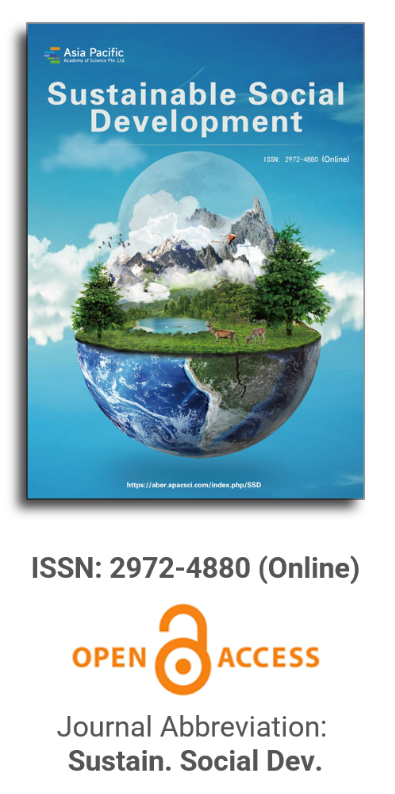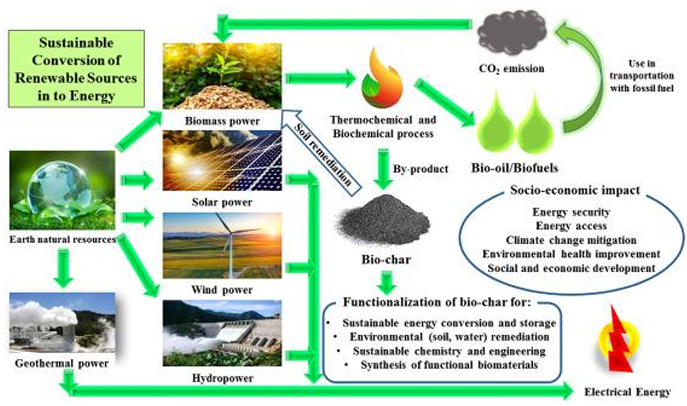
Asia Pacific Academy of Science Pte. Ltd. (APACSCI) specializes in international journal publishing. APACSCI adopts the open access publishing model and provides an important communication bridge for academic groups whose interest fields include engineering, technology, medicine, computer, mathematics, agriculture and forestry, and environment.

Heat adaptation and health in the informal housing—An exploratory research in Ahmedabad, India
Vol 2, Issue 4, 2024
Download PDF
Abstract
As the global temperature rises, Urban Heat Island (UHI) impacts are slated to enhance in the cities due to temperature increase. The informal settlement dwellings, constructed of heat-absorbing materials, having poor ventilation, and located in neighborhoods with a lack of green and open spaces, are more vulnerable to heat than the formal housing settlements. Rising temperatures are expected to adversely impact the health of the population in general and of the dwellers of the informal settlements in particular. While replacing the entire informal housing stock with formal housing requires stupendous costs, modifying this housing through introducing cool roofs is an interim physical adaptation solution to mitigate the heat impacts. The objective of this exploratory study is to assess whether built environment characteristics, with emphasis on cool roofs introduced in dwelling units in the informal settlements in Ahmedabad City in India, have improved thermal comfort within these dwelling units and, if so, whether this intervention has translated into mitigating health impacts of heat. The study reveals that the cool roofs have reduced temperatures within the dwelling unit by 1 ℃ to 1.5 ℃ during peak summer days. But other built environment characteristics such as cross ventilation, ceiling height, trees adjoining the dwelling unit, and open space in the neighborhood too have contributed toward reducing indoor temperatures. Adaptation to high temperatures in the informal settlements requires localized, doable solutions in the immediate term.
Keywords
References
- IPCC. Summary for Policymakers. Climate Change 2021: The Physical Science Basis. Cambridge University Press; 2021. pp. 3–32. doi: 10.1017/9781009157896.001
- Representative Concentration Pathways (RCPs) refer to the portion of the concentration pathway extending up to 2100, for which integrated assessment models produced corresponding emission scenarios. It includes concentrations of the full suite of greenhouse gases (GHGs) and aerosols and chemically active gases. The IPCC AR6, Working Group (WG) I has presented three RCPs, RCP2.6, RCP4.5 and RCP8.6, the first one presents slowest warming scenario and the last one the fastest. Available online: chrome-extension://efaidnbmnnnibpcajpcglclefindmkaj/https://www.ipcc.ch/report/ar6/wg1/downloads/report/IPCC_AR6_WGI_AnnexVII.pdf (accessed on 18 July 2024).
- Shared Socio-economic Pathways (SSPs) have been developed to complement the RCPs. While the RCPs present emission concentration pathways, the SSP present an assessment of emissions in association with a certain socio-economic development pathways. This integrative SSP-RCP framework is used in the IPCC’s Assessment Reports 6. Five such pathways available; SSP1, SSP2, …, SSP5. The combined scenarios are presented in the text as either SSP1-2.6, that is, combination of SSP and RCP2.6 pathway. Available online: chrome-extension://efaidnbmnnnibpcajpcglclefindmkaj/https://www.ipcc.ch/report/ar6/wg1/downloads/report/IPCC_AR6_WGI_AnnexVII.pdf (accessed on 18 July 2024).
- Ranasinghe R, Ruane AC, Vautard R, et al. Climate Change Information for Regional Impact and for Risk Assessment. Climate Change 2021—The Physical Science Basis. 2021; 1767–1926. doi: 10.1017/9781009157896.014
- Cheong WK, Timbal B, Golding N, et al. Observed and modelled temperature and precipitation extremes over Southeast Asia from 1972 to 2010. International Journal of Climatology. 2018; 38(7): 3013–3027. doi: 10.1002/joc.5479
- IPCC. Global warming of 1.5 ℃. An IPCC Special Report on the Impacts of Global Warming of 1.5 ℃ above Pre-industrial Levels and Related Global Greenhouse Gas Emission Pathways, in the Context of Strengthening the Global Response to the Threat of Climate Change, Sustainable Development and Efforts to Eradicate Poverty. Cambridge, United Kingdom and New York, NY USA: Cambridge University Press; 2018.
- Global Facility for Disaster Reduction and Recovery (GFDRR). Climate Investment Opportunities in India’s Cooling Sector. Washington DC: The World Bank; 2022.
- Krishnan R, Shrestha AB, Ren G, et al. Unravelling Climate Change in the Hindu Kush Himalaya: Rapid Warming in the Mountains and Increasing Extremes. The Hindu Kush Himalaya Assessment: Mountains, Climate Change, Sustainability and People. Cham, Switzerland: Springer; 2019. pp. 57–97. doi: 10.1007/978-3-319-92288-1_3
- Krishnan R, Sanjay J, Gnanaseelan C, et al. Assessment of Climate Change over the Indian Region: A Report of the Ministry of Earth Sciences. Springer Singapore; 2020. doi: 10.1007/978-981-15-4327-2
- Available online: https://indianexpress.com/article/world/heatwave-grips-the-globe-2024-likely-to-surpass-2023-as-hottest-year-in-history-9440961/ (accessed on 18 July 2024).
- McGrath M, Poynting M, Dale B, Tauschinski J. World Breaches Key 1.5 ℃ Warming Mark for Record Number of Days, BBC. 2023. Available online: https://www.bbc.com/news/science-environment-66857354 (accessed on 23 July 2024).
- Somvanshi A, Kaur S. Decoding the Urban Heat Stress among Indian Cities, Report. New Delhi: Centre for Science and Environment. 2024. Available online: https://www.cseindia.org/decoding-the-urban-heat-stress-among-indian-cities-12191 (accessed on 18 July 2024).
- Johnson DP, Wilson JS, Luber GC. Socioeconomic indicators of heat-related health risk supplemented with remotely sensed data. International Journal of Health Geographics. 2009; 8(1): 57. doi: 10.1186/1476-072x-8-57
- World Health Organisation (WHO). Information and Public Health Advice: Heat and health. World Heal. The Organisation; 2018.
- Eisenman DP, Wilhalme H, Tseng CH, et al. Heat Death Associations with the built environment, social vulnerability and their interactions with rising temperature. Health & Place. 2016; 41: 89–99. doi: 10.1016/j.healthplace.2016.08.007
- Asian Development Bank (ADB). Beating the Heat: Investing in Pro-Poor Solutions for Urban Resilience. Manila: ADB; 2022.
- Ahmadalipour A, Moradkhani H, Kumar M. Mortality risk from heat stress expected to hit poorest nations the hardest. Climatic Change. 2019; 152(3–4): 569–579. doi: 10.1007/s10584-018-2348-2
- Kovats S, Akhtar R. Climate, climate change and human health in Asian cities. Environment and Urbanization. 2008; 20(1): 165–175. doi: 10.1177/0956247808089154
- Kovats RS, Hajat S. Heat Stress and Public Health: A Critical Review. Annual Review of Public Health. 2008; 29(1): 41–55. doi: 10.1146/annurev.publhealth.29.020907.090843
- Hayes K, Blashki G, Wiseman J, et al. Climate change and mental health: risks, impacts and priority actions. International Journal of Mental Health Systems. 2018; 12(1). doi: 10.1186/s13033-018-0210-6
- Trang PM, Rocklöv J, Giang KB, et al. Heatwaves and Hospital Admissions for Mental Disorders in Northern Vietnam. PLOS ONE. 2016; 11(5): e0155609. doi: 10.1371/journal.pone.0155609
- World Meteorological Organization (WMO) and World Health Organization (WHO). Heatwaves and Health: Guidance on Warning System Development. 2015. Available online: https://public.wmo.int/en/resources/library/heatwaves-and-health-guidance-warning-system-development (accessed on 6 August 2024).
- Saeed F, Schleussner C, Ashfaq M. Deadly Heat Stress to Become Commonplace Across South Asia Already at 1.5 ℃ of Global Warming. Geophysical Research Letters. 2021; 48(7). doi: 10.1029/2020gl091191
- Azhar G, Saha S, Ganguly P, et al. Heat Wave Vulnerability Mapping for India. International Journal of Environmental Research and Public Health. 2017; 14(4): 357. doi: 10.3390/ijerph14040357
- Pattanaik DR, Mohapatra M, Srivastava AK, et al. Heat wave over India during summer 2015: an assessment of real time extended range forecast. Meteorology and Atmospheric Physics. 2016; 129(4): 375–393. doi: 10.1007/s00703-016-0469-6
- The Times of India (TOI). Concrete Oven: Parts of City 8 ℃ Hotter. Available online: http://epaperbeta.timesofindia.com/Article.aspx?eid=31805&articlexml=Concrete-oven-Parts-of-city-8C-hotter-17052016002025 (accessed on 16 May 2024).
- Times of India. Heat emergencies: City worst hit Abdominal Pain Tops the Chart of Cases. 2018. Available online: https://timesofindia.indiatimes.com/city/ahmedabad/heat-emergencies-city-worst-hit/articleshow/63571626.cms (accessed 27 May 2024).
- Available online: https://thewire.in/environment/ahmedabad-heat-related-emergencies-official-data-flaw (accessed on 18 July 2024).
- Dutta P, Rajput P, Mukherjee P, et al. A Successful Heat Wave Prevention in Ahmedabad Calls for Segregated Health Record: Highlights from Existing Heat Action Plan. Aerosol and Air Quality Research. 2022; 22(12): 220300. doi: 10.4209/aaqr.220300
- Tran K, Azhar G, Nair R, et al. A Cross-Sectional, Randomized Cluster Sample Survey of Household Vulnerability to Extreme Heat among Slum Dwellers in Ahmedabad, India. International Journal of Environmental Research and Public Health. 2013; 10(6): 2515–2543. doi: 10.3390/ijerph10062515
- Li D, Bou-Zeid E. Synergistic Interactions between Urban Heat Islands and Heat Waves: The Impact in Cities Is Larger than the Sum of Its Parts. Journal of Applied Meteorology and Climatology. 2013; 52(9): 2051–2064. doi: 10.1175/jamc-d-13-02.1
- Schatz J, Kucharik CJ. Seasonality of the Urban Heat Island Effect in Madison, Wisconsin. Journal of Applied Meteorology and Climatology. 2014; 53(10): 2371–2386. doi: 10.1175/jamc-d-14-0107.1
- Wang Y, Berardi U, Akbari H. The Urban Heat Island Effect in the City of Toronto. Procedia Engineering. 2015; 118: 137–144. doi: 10.1016/j.proeng.2015.08.412
- Zander KK, Cadag JR, Escarcha J, et al. Perceived heat stress increases with population density in urban Philippines. Environmental Research Letters. 2018; 13(8): 084009. doi: 10.1088/1748-9326/aad2e5
- Xu Y, Zhou D, Li Z. Research on Characteristic Analysis of Urban Heat Island in Multi-scales and Urban Planning Strategies. Procedia Engineering. 2016; 169: 175–182. doi: 10.1016/j.proeng.2016.10.021
- Soltani A, Sharifi E. Daily variation of urban heat island effect and its correlations to urban greenery: A case study of Adelaide. Frontiers of Architectural Research. 2017; 6(4): 529–538. doi: 10.1016/j.foar.2017.08.001
- Gunawardena KR, Wells MJ, Kershaw T. Utilising green and bluespace to mitigate urban heat island intensity. Science of The Total Environment. 2017; 584–585: 1040–1055. doi: 10.1016/j.scitotenv.2017.01.158
- Emmanuel R, Loconsole A. Green infrastructure as an adaptation approach to tackling urban overheating in the Glasgow Clyde Valley Region, UK. Landscape and Urban Planning. 2015; 138: 71–86. doi: 10.1016/j.landurbplan.2015.02.012
- AboElata AAA. Study the Vegetation as Urban Strategy to Mitigate Urban Heat Island in Mega City Cairo. Procedia Environmental Sciences. 2017; 37: 386–395. doi: 10.1016/j.proenv.2017.03.004
- Yu Z, Fryd O, Sun R, et al. Where and how to cool? An idealized urban thermal security pattern model. Landscape Ecology. 2020; 36(7): 2165–2174. doi: 10.1007/s10980-020-00982-1
- Rahul A, Mukherjee M, Sood A. Impact of ganga canal on thermal comfort in the city of Roorkee, India. International Journal of Biometeorology. 2020; 64(11): 1933–1945. doi: 10.1007/s00484-020-01981-2
- Borthakur M, Saikia A, Sharma K. Swelter in the city: Urban greenery and its effects on temperature in Guwahati, India. Singapore Journal of Tropical Geography. 2020; 41(3): 341–366. doi: 10.1111/sjtg.12328
- Lee JS, Kim JT, Lee MG. Mitigation of urban heat island effect and greenroofs. Indoor and Built Environment. 2013; 23(1): 62–69. doi: 10.1177/1420326x12474483
- Pramanik S, Punia M, Yu H, et al. Is dense or sprawl growth more prone to heat-related health risks? Spatial regression-based study in Delhi, India. Sustainable Cities and Society. 2022; 81: 103808. doi: 10.1016/j.scs.2022.103808
- Stone B, Hess JJ, Frumkin H. Urban Form and Extreme Heat Events: Are Sprawling Cities More Vulnerable to Climate Change Than Compact Cities? Environmental Health Perspectives. 2010; 118(10): 1425–1428. doi: 10.1289/ehp.0901879
- Elmarakby E, Khalifa M, Elshater A, Afifi S. (2020). Spatial Morphology and Urban Heat Island: Comparative Case Studies. Architecture and Urbanism: A Smart Outlook. Cham: Springer; 2020. pp. 441–454. doi: 10.1007/978-3-030-52584-2_31
- Jacobs C, Singh T, Gorti G, et al. Patterns of outdoor exposure to heat in three South Asian cities. Science of The Total Environment. 2019; 674: 264–278. doi: 10.1016/j.scitotenv.2019.04.087
- Alexandri E, Jones P. Temperature decreases in an urban canyon due to green walls and green roofs in diverse climates. Building and Environment. 2008; 43(4): 480–493. doi: 10.1016/j.buildenv.2006.10.055
- Doick K., Hutchings T. Air Temperature Regulation by Urban Trees and Green Infrastructure, Farnham, UK: Forest Research, Forest Commission. 2013. Available online: https://www.forestresearch.gov.uk/publications/air-temperature-regulation-by-urban-trees-and-green-infrastructure/ (accessed on 6 August 2024).
- Zhao Q, Yang J, Wang ZH, et al. Assessing the Cooling Benefits of Tree Shade by an Outdoor Urban Physical Scale Model at Tempe, AZ. Urban Science. 2018; 2(1): 4. doi: 10.3390/urbansci2010004
- Tomlinson CJ, Chapman L, Thornes JE, et al. Including the urban heat island in spatial heat health risk assessment strategies: a case study for Birmingham, UK. International Journal of Health Geographics. 2011; 10(1): 42. doi: 10.1186/1476-072x-10-42
- Satterthwaite D, Archer D, Colenbrander S, et al. Building Resilience to Climate Change in Informal Settlements. One Earth. 2020; 2(2): 143–156. doi: 10.1016/j.oneear.2020.02.002
- Head K, Clarke M, Bailey M, et al. Web Annex D. Report of the Systematic Review on the Effect of Indoor Heat on Health. In: WHO Housing and Health Guidelines. Geneva: World Health Organization; 2018.
- Lomas KJ, Giridharan R. Thermal comfort standards, measured internal temperatures and thermal resilience to climate change of free-running buildings: A case-study of hospital wards. Building and Environment. 2012; 55: 57–72. doi: 10.1016/j.buildenv.2011.12.006
- Jay O, Cramer MN, Ravanelli NM, et al. Should electric fans be used during a heat wave? Applied Ergonomics. 2015; 46: 137–143. doi: 10.1016/j.apergo.2014.07.013
- Song J, Huang B, Kim JS, et al. Fine-scale mapping of an evidence-based heat health risk index for high-density cities: Hong Kong as a case study. Science of The Total Environment. 2020; 718: 137226. doi: 10.1016/j.scitotenv.2020.137226
- Mahadevia D, Pathak M, Bhatia N, et al. Climate Change, Heat Waves and Thermal Comfort—Reflections on Housing Policy in India. Environment and Urbanization Asia. 2020; 11(1): 29–50. doi: 10.1177/0975425320906249
- Sverdlik A. Ill-health and poverty: A literature review on health in informal settlements. Environment and Urbanization. 2011; 23(1): 123–155. doi: 10.1177/0956247811398604
- Natural Resources Defense Council (NRDC). Rising Temperatures, Deadly Threat: Recommendations for Slum Communities in Ahmedabad. NRDC Issue Brief; 2013.
- Wilby RL, Kasei R, Gough KV, et al. Monitoring and moderating extreme indoor temperatures in low-income urban communities. Environmental Research Letters. 2021; 16(2): 024033. doi: 10.1088/1748-9326/abdbf2
- Swope CB, Hernández D. Housing as a determinant of health equity: A conceptual model. Social Science & Medicine. 2019; 243: 112571. doi: 10.1016/j.socscimed.2019.112571
- Arumugam RS, Garg V, Ram VV, et al. Optimizing roof insulation for roofs with high albedo coating and radiant barriers in India. Journal of Building Engineering. 2015; 2: 52–58. doi: 10.1016/j.jobe.2015.04.004
- Jaiswal A. New Cool Roof Programs in India—Ahmedabad, Part 2. NRDC Blog. Available online: https://www.nrdc.org/experts/anjali-jaiswal/new-cool-roof-programs-india-ahmedabad-part-2 (accessed on 6 August 2024).
- Gill, V. Whitest Ever Paint Reflects 98% of Sunlight, BBC News. 2021. Available online: https://www.bbc.co.uk/news/science-environment-56749105 (accessed on 22 July 2024).
- Goldstein DB, Kaur-Alum N, Kwatra S. Hyderabad Announces Cool Roofs Initiative with Experts. Available online: https://www.nrdc.org/experts/david-b-goldstein/hyderabad-announces-cool-roofs-initiative-experts (accessed on 6 August 2024).
- Hugo JM. Heat stress: adaptation measures in South African informal settlements. Buildings and Cities. 2023; 4(1): 55–73. doi: 10.5334/bc.269
- Vellingiri S. Combating Climate Change-Induced Heat Stress: Assessing Cool Roofs and Its Impact on the Indoor Ambient Temperature of the Households in the Urban Slums of Ahmedabad. Indian Journal of Occupational and Environmental Medicine. 2020; 24: 25–29. doi: 10.4103/ijoem.IJOEM_120_19
- Available online: https://www.thehindubusinessline.com/news/science/how-ahmedabad-tackled-its-heat-waves-and-saved-1000-lives-a-year/article65083634.ece (accessed on 18 July 2024).
- Available online: https://www.thehindu.com/sci-tech/health/heat-action-plan-lessons-from-ahmedabad/article68115622.ece (accessed on 18 July 2024).
- Available online: https://www.thebetterindia.com/97105/mahila-housing-trust-cooling-roofs-slums/ (accessed on 9 July 2024)).
- Gauer RL, Meyers BK. Heat-related illnesses, Am. Fam. Physician. 2019; 99: 482–489.
- Petzold J, Mose L. Urban Greening as a Response to Climate-Related Heat Risk: A Social–Geographical Review. Sustainability. 2023; 15(6): 4996. doi: 10.3390/su15064996
- Ahmedabad Municipal Corporation (AMC). Ahmedabad Heat Action Plan 2016. Ahmedabad: Ahmedabad Municipal Corporation (AMC); 2016. Available online: https://www.nrdc.org/sites/default/files/ahmedabad-heat-action-plan-2016.pdf (accessed on 6 August 2024).
- Lundgren Kownacki K, Gao C, Kuklane K, et al. Heat Stress in Indoor Environments of Scandinavian Urban Areas: A Literature Review. International Journal of Environmental Research and Public Health. 2019; 16(4): 560. doi: 10.3390/ijerph16040560
- Available online: https://power.larc.nasa.gov/data-access-viewer/ (accessed on 7 July 2024).
- Parikh J, Mishra M. Upadhyay DAssessment of Vulnerabilities of Indian Cities to Climate Change. Urban India. 2011; 31(2): 1–23.
- Ahmedabad Urban Development Authority (AUDA). Comprehensive Development plan 2021, second revised, Part I: Existing Conditions. Studies & Analysis. Ahmedabad: Ahmedabad Urban Development Authority (AUDA); n.d.
- Available online: https://www.timeanddate.com/weather/india/ahmadabad/historic?month=6&year=2022 (accessed on 1 July 2024).
- Faheem M, Bhandari N, Tadepalli S. Adaptive thermal comfort in naturally ventilated hostels of warm and humid climatic region, Tiruchirappalli, India. Energy and Built Environment. 2023; 4(5): 530–542. doi: 10.1016/j.enbenv.2022.04.002
- Rawal R, Shukla Y, Vardhan V, et al. Adaptive thermal comfort model based on field studies in five climate zones across India. Building and Environment. 2022; 219: 109187. doi: 10.1016/j.buildenv.2022.109187
Supporting Agencies
Copyright (c) 2024 Darshini Mahadevia
License URL: https://creativecommons.org/licenses/by/4.0/

This site is licensed under a Creative Commons Attribution 4.0 International License (CC BY 4.0).

Prof. Kittisak Jermsittiparsert
University of City Island, Cyprus






It is with deep regret that we announce the cancellation of the Forum on Sustainable Social Development & Computing and Artificial Intelligence, originally scheduled for June 15, 2025.

